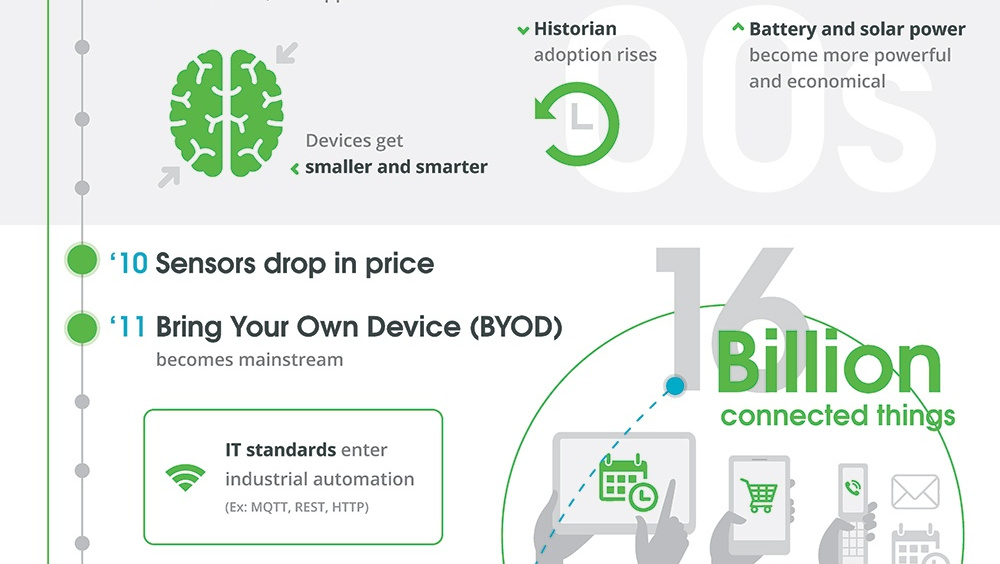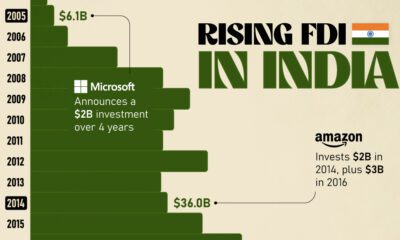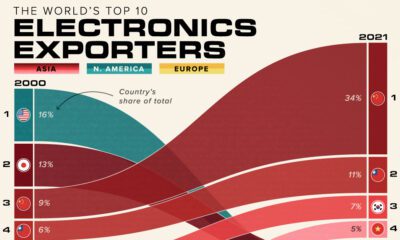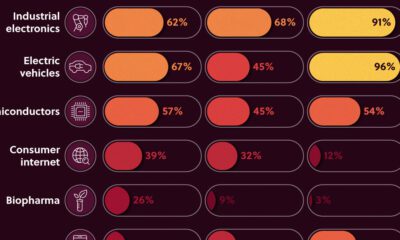Technology
Timeline: The History of the Industrial Internet of Things
The Internet of Things (IoT) isn’t only for connecting the latest gadgets, like a voice-activated speaker or a smart thermostat, to your increasingly connected home.
In fact, the same circumstances that have led to the explosion in smart consumer gadgets, such as universal wireless connectivity, cloud computing, cheap sensors, and better artificial intelligence, are also being used in conjunction with big data to power the next generation of industry, as well.
This new technological layer, called the Industrial Internet of Things (IIoT), is transforming massive industries like manufacturing, energy, mining, and transportation – and it’ll have a multi-trillion dollar impact on the economy as a whole.
The Birth of the Industrial Internet
Today’s infographic comes to us from Kepware, and it shows how these technological forces have emerged over time to make the IIoT possible.

The road to the creation of the IIoT started in 1968, when engineer Dick Morley made one of the most important breakthroughs in manufacturing history.
That year, Morley and a group of geek friends invented the programmable logic controller (PLC), which would eventually become irreplaceable in automating assembly lines and industrial robots in factories.
Other Major Innovations
Here are some other major innovations that were instrumental in making the IIoT possible:
1983: Ethernet is standardized
1989: Tim Berners-Lee creates Hypertext Transfer Protocol (HTTP)
1992: TCP/IP allows PLCs to have connectivity
2002: Amazon Web Services launches, and cloud computing starts to take hold
2006: OPC Unified Architecture (UA) enables secure communications between devices, data sources, and applications.
2006: Devices start getting smaller, and batteries and solar energy are becoming powerful and more economical.
2010: Sensors drop in price, enabling them to be put into pretty much everything
And today, the IIoT is a big deal: it’s transforming the backbone of major industries by adding a new layer of technology that helps companies optimize operations, track and analyze equipment, implement predictive maintenance, make sense of massive amounts of data, and make real-time decisions that were never before possible.
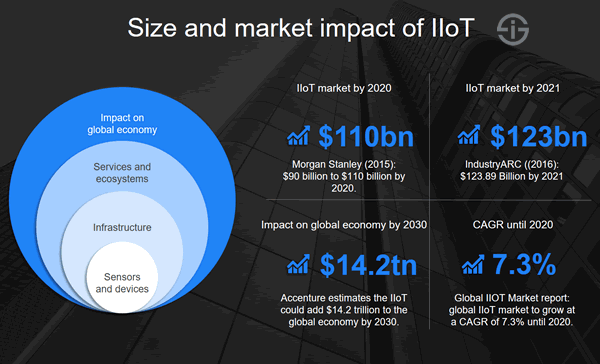
And by 2030, the IIoT is estimated by Accenture to have a $14.2 trillion on the global economy – making it one of the most important forces shaping the future business world today.
Technology
Ranked: Semiconductor Companies by Industry Revenue Share
Nvidia is coming for Intel’s crown. Samsung is losing ground. AI is transforming the space. We break down revenue for semiconductor companies.
Semiconductor Companies by Industry Revenue Share
This was originally posted on our Voronoi app. Download the app for free on Apple or Android and discover incredible data-driven charts from a variety of trusted sources.
Did you know that some computer chips are now retailing for the price of a new BMW?
As computers invade nearly every sphere of life, so too have the chips that power them, raising the revenues of the businesses dedicated to designing them.
But how did various chipmakers measure against each other last year?
We rank the biggest semiconductor companies by their percentage share of the industry’s revenues in 2023, using data from Omdia research.
Which Chip Company Made the Most Money in 2023?
Market leader and industry-defining veteran Intel still holds the crown for the most revenue in the sector, crossing $50 billion in 2023, or 10% of the broader industry’s topline.
All is not well at Intel, however, with the company’s stock price down over 20% year-to-date after it revealed billion-dollar losses in its foundry business.
| Rank | Company | 2023 Revenue | % of Industry Revenue |
|---|---|---|---|
| 1 | Intel | $51B | 9.4% |
| 2 | NVIDIA | $49B | 9.0% |
| 3 | Samsung Electronics | $44B | 8.1% |
| 4 | Qualcomm | $31B | 5.7% |
| 5 | Broadcom | $28B | 5.2% |
| 6 | SK Hynix | $24B | 4.4% |
| 7 | AMD | $22B | 4.1% |
| 8 | Apple | $19B | 3.4% |
| 9 | Infineon Tech | $17B | 3.2% |
| 10 | STMicroelectronics | $17B | 3.2% |
| 11 | Texas Instruments | $17B | 3.1% |
| 12 | Micron Technology | $16B | 2.9% |
| 13 | MediaTek | $14B | 2.6% |
| 14 | NXP | $13B | 2.4% |
| 15 | Analog Devices | $12B | 2.2% |
| 16 | Renesas Electronics Corporation | $11B | 1.9% |
| 17 | Sony Semiconductor Solutions Corporation | $10B | 1.9% |
| 18 | Microchip Technology | $8B | 1.5% |
| 19 | Onsemi | $8B | 1.4% |
| 20 | KIOXIA Corporation | $7B | 1.3% |
| N/A | Others | $126B | 23.2% |
| N/A | Total | $545B | 100% |
Note: Figures are rounded. Totals and percentages may not sum to 100.
Meanwhile, Nvidia is very close to overtaking Intel, after declaring $49 billion of topline revenue for 2023. This is more than double its 2022 revenue ($21 billion), increasing its share of industry revenues to 9%.
Nvidia’s meteoric rise has gotten a huge thumbs-up from investors. It became a trillion dollar stock last year, and broke the single-day gain record for market capitalization this year.
Other chipmakers haven’t been as successful. Out of the top 20 semiconductor companies by revenue, 12 did not match their 2022 revenues, including big names like Intel, Samsung, and AMD.
The Many Different Types of Chipmakers
All of these companies may belong to the same industry, but they don’t focus on the same niche.
According to Investopedia, there are four major types of chips, depending on their functionality: microprocessors, memory chips, standard chips, and complex systems on a chip.
Nvidia’s core business was once GPUs for computers (graphics processing units), but in recent years this has drastically shifted towards microprocessors for analytics and AI.
These specialized chips seem to be where the majority of growth is occurring within the sector. For example, companies that are largely in the memory segment—Samsung, SK Hynix, and Micron Technology—saw peak revenues in the mid-2010s.
-

 Business2 weeks ago
Business2 weeks agoAmerica’s Top Companies by Revenue (1994 vs. 2023)
-

 Environment2 weeks ago
Environment2 weeks agoRanked: Top Countries by Total Forest Loss Since 2001
-

 Markets2 weeks ago
Markets2 weeks agoVisualizing America’s Shortage of Affordable Homes
-

 Maps2 weeks ago
Maps2 weeks agoMapped: Average Wages Across Europe
-

 Mining2 weeks ago
Mining2 weeks agoCharted: The Value Gap Between the Gold Price and Gold Miners
-

 Demographics2 weeks ago
Demographics2 weeks agoVisualizing the Size of the Global Senior Population
-

 Misc2 weeks ago
Misc2 weeks agoTesla Is Once Again the World’s Best-Selling EV Company
-

 Technology2 weeks ago
Technology2 weeks agoRanked: The Most Popular Smartphone Brands in the U.S.

